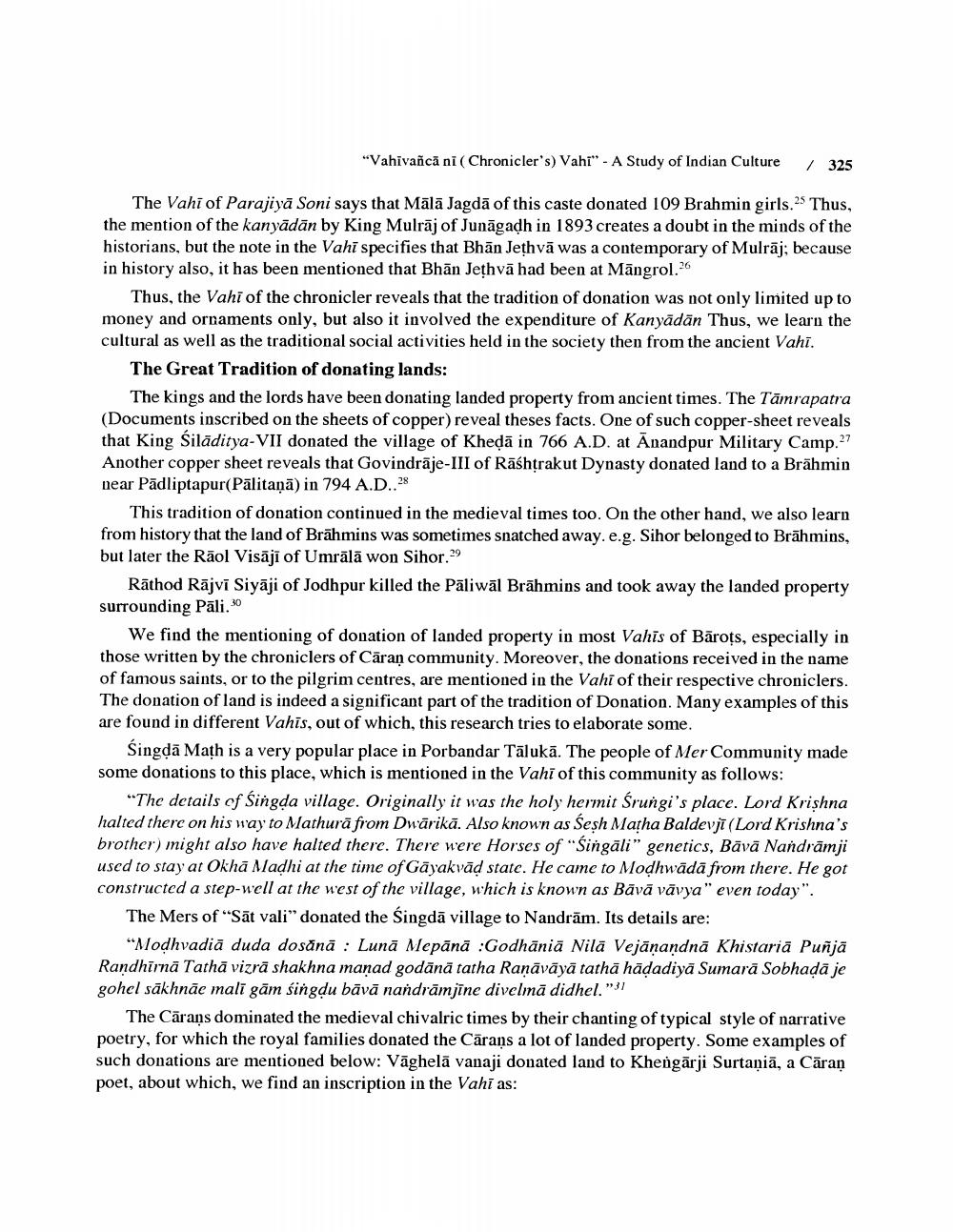________________
"Vahivañcã ni ( Chronicler's) Vahi” - A Study of Indian Culture
/ 325
The Vahi of Parajiya Soni says that Mālā Jagdā of this caste donated 109 Brahmin girls.25 Thus, the mention of the kanyādān by King Mulrāj of Junāgadh in 1893 creates a doubt in the minds of the historians, but the note in the Vahi specifies that Bhān Jethvā was a contemporary of Mulrāj; because in history also, it has been mentioned that Bhān Jethvā had been at Māngrol.26
Thus, the Vahi of the chronicler reveals that the tradition of donation was not only limited up to money and ornaments only, but also it involved the expenditure of Kanyādān Thus, we learn the cultural as well as the traditional social activities held in the society then from the ancient Vahi.
The Great Tradition of donating lands:
The kings and the lords have been donating landed property from ancient times. The Tāmrapatra (Documents inscribed on the sheets of copper) reveal theses facts. One of such copper-sheet reveals that King Silāditya-VII donated the village of Khedā in 766 A.D. at Anandpur Military Camp.27 Another copper sheet reveals that Govindrāje-III of Rāshtrakut Dynasty donated land to a Brāhmin near Pādliptapur(Pālitaņā) in 794 A.D..28
This tradition of donation continued in the medieval times too. On the other hand, we also learn from history that the land of Brāhmins was sometimes snatched away.e.g. Sihor belonged to Brāhmins, but later the Rāol Visājī of Umrālā won Sihor.
Rāthod Rājvi Siyāji of Jodhpur killed the Pāliwāl Brāhmins and took away the landed property surrounding Päli. 30
We find the mentioning of donation of landed property in most Vahis of Bärots, especially in those written by the chroniclers of Cāram community. Moreover, the donations received in the name of famous saints, or to the pilgrim centres, are mentioned in the Vahi of their respective chroniclers. The donation of land is indeed a significant part of the tradition of Donation. Many examples of this are found in different Vahis, out of which, this research tries to elaborate some.
Singdā Math is a very popular place in Porbandar Tālukā. The people of Mer Community made some donations to this place, which is mentioned in the Vahi of this community as follows:
"The details of Singda village. Originally it was the holy hermit Śrungi's place. Lord Krishna halted there on his way to Mathurā from Duārikā. Also known as Sesh Maha Baldevji (Lord Krishna's brother) might also have halted there. There were Horses of "Singāli" genetics, Bāvā Nandrāmji used to stay at Okhā Madhi at the time of Gāyakvād state. He came to Modhwādā from there. He got constructed a step-well at the west of the village, which is known as Bāvā vāvya" even today".
The Mers of “Sāt vali” donated the singdā village to Nandrām. Its details are:
"Modhvadiā duda dosănā : Lunā Mepānā :Godhānia Nila Vejānandnā Khistariā Puñjā Randhīnā Tathā vizrā shakhna manad godānā tatha Raņāvāyā tathā hādadiyā Sumarā Sobhaļā je gohel sākhnae mali gām singdu bāvā nandrāmjine divelmā didhel."31
The Cārans dominated the medieval chivalric times by their chanting of typical style of narrative poetry, for which the royal families donated the Cāraṇs a lot of landed property. Some examples of such donations are mentioned below: Vāghelā vanaji donated land to Khengārji Surtaņiā, a Cāran poet, about which, we find an inscription in the Vahi as:




